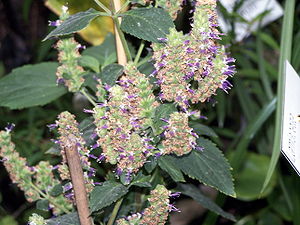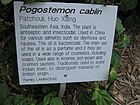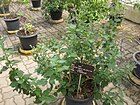Note: This is a project under development. The articles on this wiki are just being initiated and broadly incomplete. You can Help creating new pages.
Difference between revisions of "Pogostemon cablin - Patchouli"
m (Prabhakar moved page Patchouli to Patchouli (Pogostemon cablin)) |
|||
| (10 intermediate revisions by 2 users not shown) | |||
| Line 1: | Line 1: | ||
[[File:Pogostemon cablin 001.jpg|thumb|right|''Patchouli'']] | [[File:Pogostemon cablin 001.jpg|thumb|right|''Patchouli'']] | ||
| + | '''Pogostemon cablin''' is a species of plant from the genus Pogostemon. It is a bushy herb of the mint family with erect stems. It can grows up to 3feet tall. It bearing small, pale pink-white flowers. The plant is native to tropical regions of Asia and is now extensively cultivated in China, Indonesia, Cambodia, Myanmar, India, Maldives, Malaysia, Mauritius, Seychelles, Madagascar, Taiwan, Philippines, Thailand, Vietnam, South America and the Caribbean. | ||
| + | ==Uses== | ||
| + | {{Uses|Cold}}, {{Uses|Headaches}}, {{Uses|Nausea}}, {{Uses|Vomiting}}, {{Uses|Abdominal pain}}, {{Uses|Halitosis}}, {{Uses|Skin problems}}, {{Uses|Diarrhea}}, {{Uses|Snake bite}} | ||
| − | + | ==Parts Used== | |
| + | {{Parts Used|Leaves}}, {{Parts Used|Flowers}}. | ||
| − | == | + | ==Chemical Composition== |
| − | + | Terpenoids, phytosterols, flavonoids, organic acids, lignins, alkaloids, glycosides, alcohols, aldehydes have been isolated and identified from patchouli.<ref name="chemical composition"/> | |
| − | |||
| − | == | + | ==Common names== |
| − | + | {{Common names|kn=|ml=|sa=|ta=|te=|hi=|en=Patchouli}} | |
| − | |||
| − | |||
| − | |||
| − | |||
| − | == | + | ==Properties== |
| + | Reference: Dravya - Substance, Rasa - Taste, Guna - Qualities, Veerya - Potency, Vipaka - Post-digesion effect, Karma - Pharmacological activity, Prabhava - Therepeutics. | ||
| + | ===Dravya=== | ||
| − | + | ===Rasa=== | |
| − | + | Tikta (Bitter), Kashaya (Astringent) | |
| + | ===Guna=== | ||
| + | Laghu (Light), Ruksha (Dry), Tikshna (Sharp) | ||
| + | ===Veerya=== | ||
| + | Ushna (Hot) | ||
| + | ===Vipaka=== | ||
| + | Katu (Pungent) | ||
| + | ===Karma=== | ||
| + | Kapha, Vata | ||
| + | ===Prabhava=== | ||
| − | == References == | + | ==Habit== |
| − | + | {{Habit|Perennial plant}} | |
| − | <references> | + | |
| − | <ref name=" | + | ==Identification== |
| − | <ref name=" | + | ===Leaf=== |
| − | <ref name=" | + | {{Leaf|Simple|Opposite|Rounded to broadly ovate, 2 to 10cm long, 2.5 to 7cm with, and with acute or obtuse apex}}<ref name="Leaf"/> |
| + | |||
| + | ===Flower=== | ||
| + | {{Flower|Unisexual|2-4cm long|Purple|5|Flowers Season is June - August}} | ||
| + | |||
| + | ===Fruit=== | ||
| + | {{Fruit|General|7–10 mm|Nutlets are nearly spherical and slightly flattened||}} | ||
| + | |||
| + | ===Other features=== | ||
| + | |||
| + | ==List of Ayurvedic medicine in which the herb is used== | ||
| + | |||
| + | ==Where to get the saplings== | ||
| + | ==Mode of Propagation== | ||
| + | {{Propagation|Seeds}}, {{Propagation|Cuttings}}. | ||
| + | |||
| + | ==How to plant/cultivate== | ||
| + | A plant of the moist tropics, where it is found at elevations from 1,000 - 2,000 metres.<ref name="How to plant/cultivate"/> | ||
| + | |||
| + | ==Commonly seen growing in areas== | ||
| + | {{Commonly seen|Trophical region}}, {{Commonly seen|Subtrophical region}}, {{Commonly seen|Borders of forests and fields}}. | ||
| + | |||
| + | ==Photo Gallery== | ||
| + | <gallery class="left" caption="" widths="140px" heights="140px"> | ||
| + | Gardenology.org-IMG 2910 rbgs11jan.jpg | ||
| + | Gardenology.org-IMG 2911 rbgs11jan.jpg | ||
| + | Gardenology.org-IMG 2912 rbgs11jan.jpg | ||
| + | Gardenology.org-IMG 2913 rbgs11jan.jpg | ||
| + | Gardenology.org-IMG 7841 qsbg11mar.jpg | ||
| + | Gardenology.org-IMG 7842 qsbg11mar.jpg | ||
| + | Gardenology.org-IMG 8067 qsbg11mar.jpg | ||
| + | File:Agrimonia eupatoria02.jpg | ||
| + | </gallery> | ||
| + | |||
| + | ==References== | ||
| + | |||
| + | <references> | ||
| + | <ref name="chemical composition">[https://www.ncbi.nlm.nih.gov/pubmed/25985355 Phytochemical Constituents]</ref> | ||
| + | |||
| + | <ref name="Leaf">[http://www.chineseherbshealing.com/patchouli/ Plant description]</ref> | ||
| + | |||
| + | <ref name="How to plant/cultivate">[http://www.tropical.theferns.info/viewtropical.php?id=Pogostemon+cablin Cultivation Details]</ref> | ||
</references> | </references> | ||
| − | == External Links == | + | ==External Links== |
| − | + | * [http://evelynparham.com/10-medicinal-uses-and-health-benefits-of-patchouli-essential-oil/ Pogostemon cablin-Uses and Health Benefits of Patchouli Essential Oil ] | |
| − | *[https:// | + | * [http://entheology.com/plants/pogostemon-cablin-patchouli/ Pogostemon cablin on entheology.com] |
| + | * [http://www.chineseherbshealing.com/patchouli/ Pogostemon cablin on chinese herbs healing] | ||
| + | * [https://articles.mercola.com/herbal-oils/patchouli-oil.aspx Pogostemon cablin on articles.mercola.com] | ||
[[Category:Herbs]] | [[Category:Herbs]] | ||
| + | [[Category:Lamiaceae]] | ||
Latest revision as of 15:31, 7 July 2020
Pogostemon cablin is a species of plant from the genus Pogostemon. It is a bushy herb of the mint family with erect stems. It can grows up to 3feet tall. It bearing small, pale pink-white flowers. The plant is native to tropical regions of Asia and is now extensively cultivated in China, Indonesia, Cambodia, Myanmar, India, Maldives, Malaysia, Mauritius, Seychelles, Madagascar, Taiwan, Philippines, Thailand, Vietnam, South America and the Caribbean.
Contents
- 1 Uses
- 2 Parts Used
- 3 Chemical Composition
- 4 Common names
- 5 Properties
- 6 Habit
- 7 Identification
- 8 List of Ayurvedic medicine in which the herb is used
- 9 Where to get the saplings
- 10 Mode of Propagation
- 11 How to plant/cultivate
- 12 Commonly seen growing in areas
- 13 Photo Gallery
- 14 References
- 15 External Links
Uses
Cold, Headaches, Nausea, Vomiting, Abdominal pain, Halitosis, Skin problems, Diarrhea, Snake bite
Parts Used
Chemical Composition
Terpenoids, phytosterols, flavonoids, organic acids, lignins, alkaloids, glycosides, alcohols, aldehydes have been isolated and identified from patchouli.[1]
Common names
| Language | Common name |
|---|---|
| Kannada | |
| Hindi | |
| Malayalam | |
| Tamil | |
| Telugu | |
| Marathi | NA |
| Gujarathi | NA |
| Punjabi | NA |
| Kashmiri | NA |
| Sanskrit | |
| English | Patchouli |
Properties
Reference: Dravya - Substance, Rasa - Taste, Guna - Qualities, Veerya - Potency, Vipaka - Post-digesion effect, Karma - Pharmacological activity, Prabhava - Therepeutics.
Dravya
Rasa
Tikta (Bitter), Kashaya (Astringent)
Guna
Laghu (Light), Ruksha (Dry), Tikshna (Sharp)
Veerya
Ushna (Hot)
Vipaka
Katu (Pungent)
Karma
Kapha, Vata
Prabhava
Habit
Identification
Leaf
| Kind | Shape | Feature |
|---|---|---|
| Simple | Opposite | Rounded to broadly ovate, 2 to 10cm long, 2.5 to 7cm with, and with acute or obtuse apex |
Flower
| Type | Size | Color and composition | Stamen | More information |
|---|---|---|---|---|
| Unisexual | 2-4cm long | Purple | 5 | Flowers Season is June - August |
Fruit
| Type | Size | Mass | Appearance | Seeds | More information |
|---|---|---|---|---|---|
| General | 7–10 mm | Nutlets are nearly spherical and slightly flattened | {{{6}}} |
Other features
List of Ayurvedic medicine in which the herb is used
Where to get the saplings
Mode of Propagation
How to plant/cultivate
A plant of the moist tropics, where it is found at elevations from 1,000 - 2,000 metres.[3]
Commonly seen growing in areas
Trophical region, Subtrophical region, Borders of forests and fields.
Photo Gallery
References
External Links
- Ayurvedic Herbs known to be helpful to treat Cold
- Ayurvedic Herbs known to be helpful to treat Headaches
- Ayurvedic Herbs known to be helpful to treat Nausea
- Ayurvedic Herbs known to be helpful to treat Vomiting
- Ayurvedic Herbs known to be helpful to treat Abdominal pain
- Ayurvedic Herbs known to be helpful to treat Halitosis
- Ayurvedic Herbs known to be helpful to treat Skin problems
- Ayurvedic Herbs known to be helpful to treat Diarrhea
- Ayurvedic Herbs known to be helpful to treat Snake bite
- Herbs with Leaves used in medicine
- Herbs with Flowers used in medicine
- Herbs with common name in English
- Habit - Perennial plant
- Index of Plants which can be propagated by Seeds
- Index of Plants which can be propagated by Cuttings
- Herbs that are commonly seen in the region of Trophical region
- Herbs that are commonly seen in the region of Subtrophical region
- Herbs that are commonly seen in the region of Borders of forests and fields
- Herbs
- Lamiaceae








